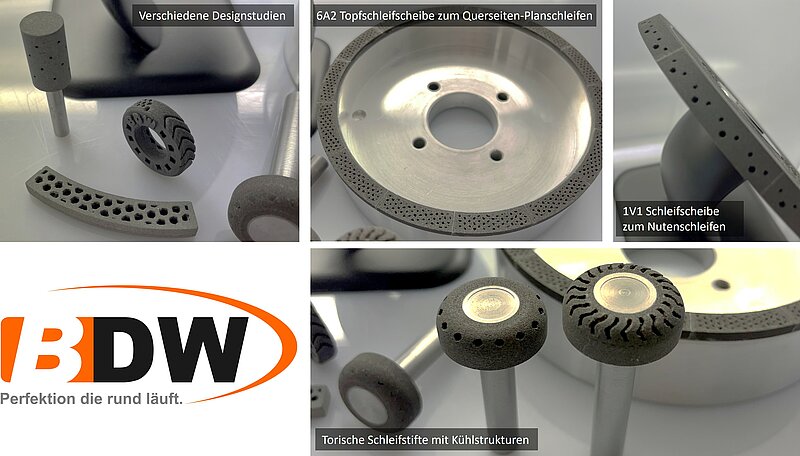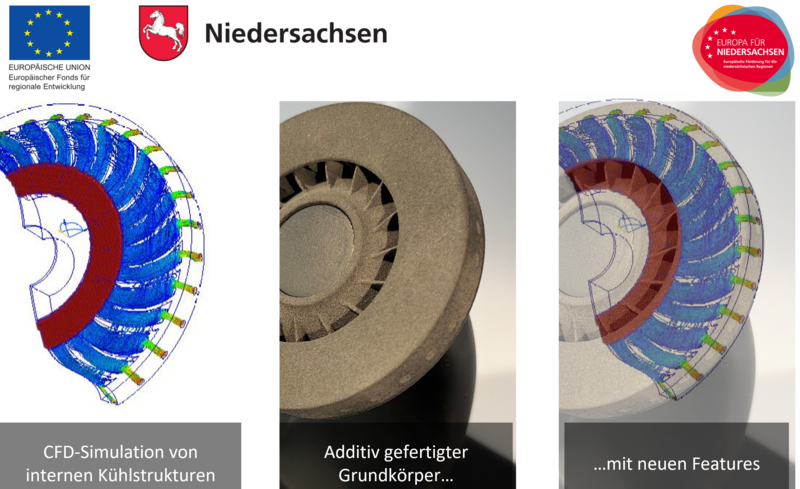Diamonds are created by pressure
The development and use of the latest 3D printing processes and materials expands the possibilities in the production of high-hardness, ceramic-bonded grinding tools at BDW-Binka Diamantwerkzeug GmbH. In addition to the incorporation of new types of application-specific geometries in abrasive coatings and basic bodies, a significant reduction in delivery times is also achieved.
BDW-Binka Diamantwerkzeug GmbH (BDW for short) manufactures diamond and CBN grinding tools that are specially adapted to customer requirements. Flexibility, speed and quality are the guiding concepts that are the focus of our work. Therefore, the integration of additive manufacturing, due to its degrees of freedom but also automation as well as scalability, is a logical conclusion. BDW not only benefits from the advantages of the latest additive processes and materials, but also continues to develop them in its own research projects.
New features in the abrasive bond
The application portfolio for the printable, ceramic bonded abrasive coating bonds for both diamond and CBN tools is being successively expanded (see image 1). 3D printing of the ceramic linings enables the creation of macroscopic pore structures that can usefully overlay the microscopic pore structure between the ceramic bond bridges. This feature has the potential to reduce both thermal and mechanical stresses in the grinding process.
Particularly in grinding processes with large-area and/or contact areas that are difficult for the coolant to access, these novel grinding coatings offer an advantage over currently common solutions. Thus, not only can critical thermal damage to the workpiece and tool be avoided due to the improved cooling lubricant accessibility, but the pressure of coolant systems can also be reduced and energy costs saved. The design of the coatings and the pore structures is computer-aided at BDW and can therefore be flexibly adapted in size and position to the grinding task. Currently, abrasive grit sizes in D15-D126 (or B15-B126) can be processed.
Additive base body production
The knowledge and experience gained from additive manufacturing of grinding linings is also incorporated into the production of grinding wheel base bodies. The free design options allow, for example, the insertion of internal structures that can promote the supply of cooling lubricant to the grinding effective point. The shape and design of the structures are adapted by BDW simulatively to the flow situation and to the macroscopic pore structures in the grinding layer (see image 2).
Additive manufacturing at BDW is near-net-shape and requires only minimal post-processing. Together with the high degree of automation of the process, unmanned basic body production can be implemented in additional shifts.
Increase in delivery speed and delivery reliability
A major gain is additive manufacturing in mold making for the production of press and sinter molds in the conventional process chain for the production of high-hardness, ceramic abrasive coatings. Here, cost-intensive steel and graphite molds have been completely replaced by printed molds and BDW manufactures these independently.
This opens up new possibilities for responding to individual customer wishes with regard to abrasive coating dimensions. Short-term change requests and iterative adjustments can be implemented quickly and easily, as new molds can be produced within a few hours. In addition to the responsiveness of production, resilience to supply bottlenecks and delays has also been improved due to the increased independence from suppliers.
The additive manufacturing of press and sinter molds as well as grinding tools results in a significant reduction in delivery time while further increasing our delivery reliability even in an environment of failure-prone supply chains.
Acknowledgement and appreciation
Parts of the presented products and studies have been funded within the ZIM project "Additive grinding wheel base production" and "Development of a sintering process with lost molds for the production of grinding tools" within the framework of the Central Innovation Program for SMEs by the German Federal Ministry for Economic Affairs and Energy based on a decision of the German Bundestag. Further content is funded in the project "Additive manufacturing of grinding wheel bodies with internal cooling system for flute grinding of shank tools" in the period from 01.09.2020 - 31.12.2022 with funds from the European Regional Development Fund. We thank the sponsors for their support.
![[Translate to English:] InDiamond.world](/fileadmin/_processed_/a/1/csm_InDiamond_Logo_2021_1fb017de30.png)

